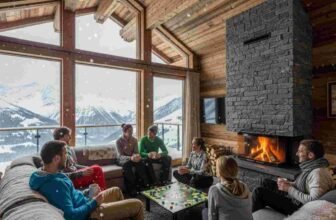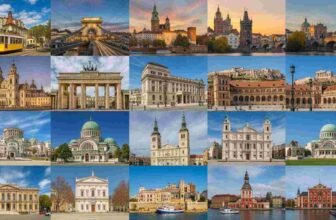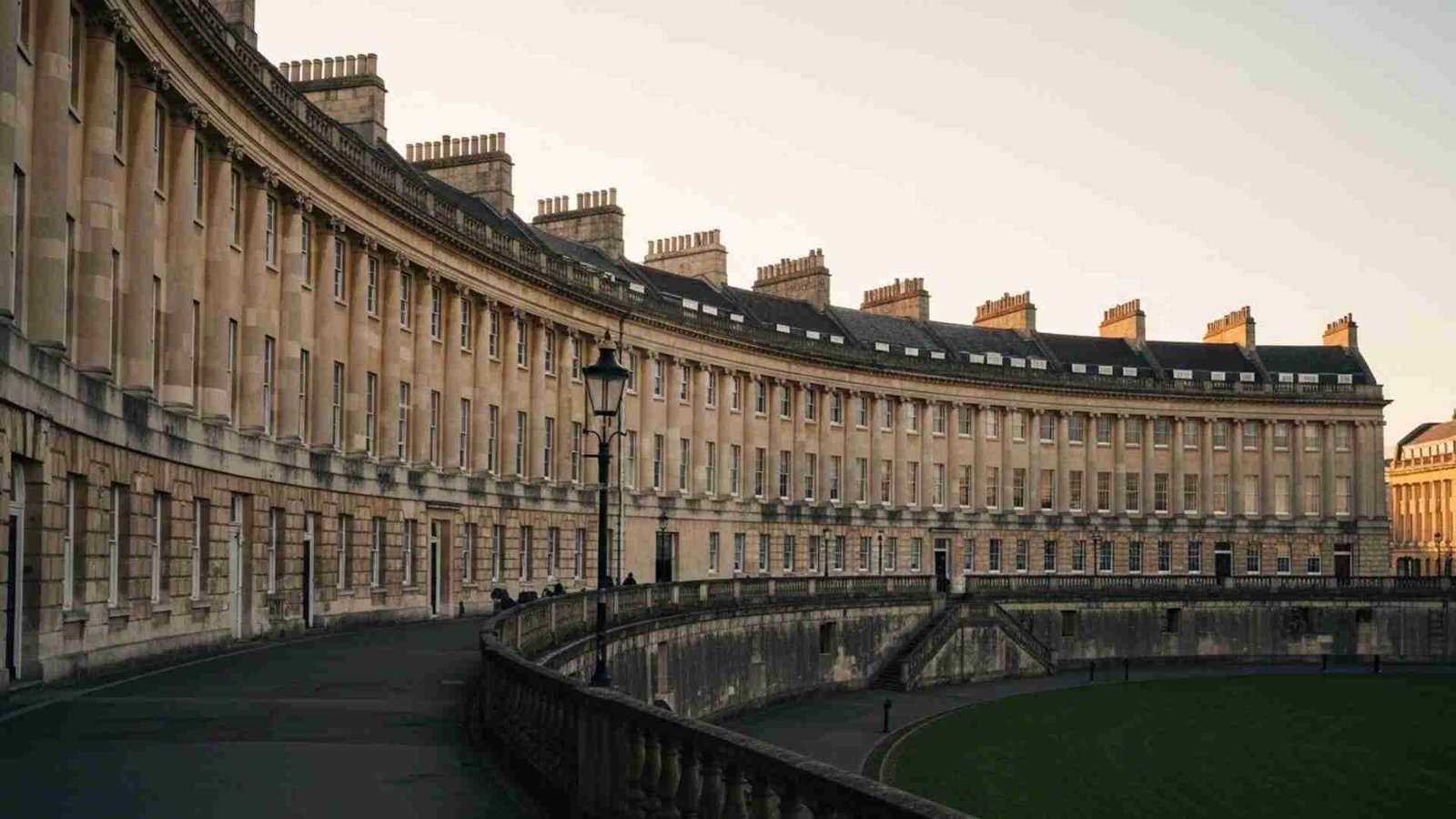

Carriage wheel turns on cobblestones, silk rustles in the breeze, and for a heartbeat, it feels like the 19th century again. Across Europe, elegant estates and storybook towns still whisper of romance, ambition, and secret rendezvous — the kind that make Bridgerton’s world so intoxicating.
In an age where travel often feels rushed and digital, these places invite you to slow down, to wander through history you can touch. Every chandeliered hall and manicured garden holds a story waiting to be rediscovered. Ahead, you’ll find the most enchanting real-world settings where fantasy and history gracefully intertwine.
1. Blenheim Palace (Oxfordshire, England)
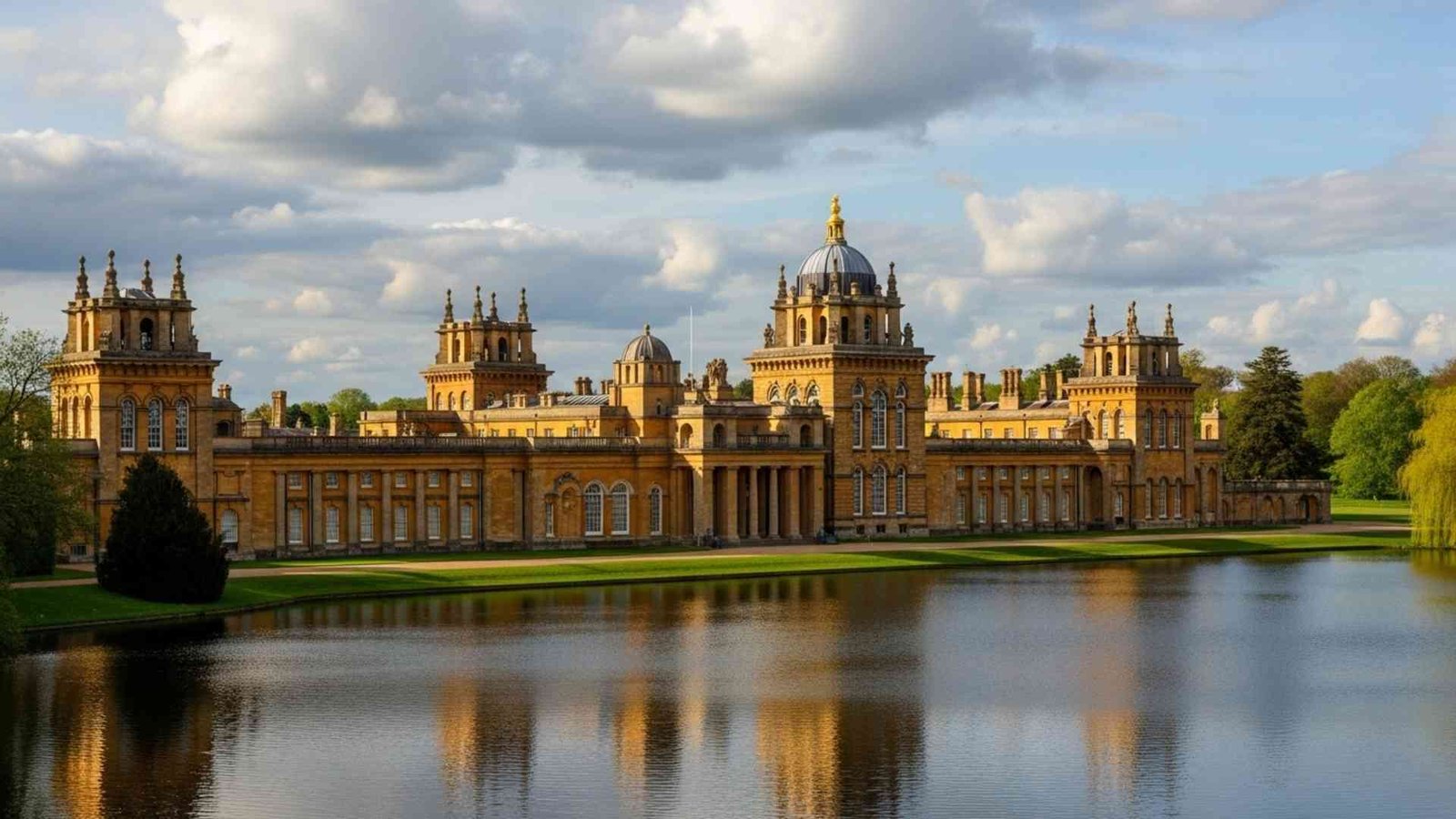
Blenheim Palace isn’t just another stately home — it’s a world of grandeur you can walk right into. Set amid 2,000 acres of Capability Brown–designed parkland, it’s where baroque architecture meets royal history. Every corridor tells a story: Winston Churchill was born here, and the palace itself has appeared in dozens of period dramas. Step outside and the lake mirrors the sky, the formal gardens unfold like a royal invitation, and the whole place hums with that “aristocratic summer ball” energy.
Beyond its beauty, Blenheim is also a living estate. It employs over 300 people, draws around 950,000 visitors a year, and fuels the local economy by tens of millions of pounds annually. Even in 2025, it’s undergoing a £12 million roof restoration — proving that history isn’t frozen here; it’s still being cared for. Wander the Long Library, peek into Churchill’s birth room, then take a lazy stroll by the lake where swans drift like floating chandeliers
Key Practical Information:
- Location: Woodstock, Oxfordshire (8 mi NW of Oxford)
- Getting There: From Oxford, Stagecoach S3 bus (30 min) or taxi (15 min)
- Opening Hours: Daily 10:00 am – 5:00 pm (gardens open later in summer)
- Tickets (2025): Adults £36, Children £20, Family £90 (book online for 10% off)
- Best Time: April–June (spring blooms) & September (lighter crowds)
- Ideal Duration: Half day (3–5 hours)
- On-Site: Cafés, picnic areas, seasonal events, gift shops.
2.Hampton Court Palace (Surrey, England)

If any place captures Bridgerton’s royal drama, it’s Hampton Court Palace. Built in 1515 for Cardinal Wolsey, later claimed by Henry VIII, and expanded by William III and Mary II, this palace is a tapestry of Tudor and Baroque eras woven together. The architecture alone is a time capsule, but it’s the details — vast kitchens, haunted halls, and the famous Maze — that make it come alive. You half-expect to spot the Duke of Hastings rounding a corridor.
Today, Hampton Court is both museum and parkland, spread over 60 acres of gardens. It’s meticulously preserved and refreshingly accessible. Guided tours, live costumed interpreters, and modern cafés make it a welcoming mix of history and ease. Even the air smells of roses and history (literally — the Rose Garden is one of the prettiest in London).
Key Practical Information:
- Location: East Molesey, Surrey (12 mi SW of London)
- Getting There: Train from London Waterloo → Hampton Court (35–40 min)
- Opening Hours: Wed–Sun 10:00 am – 5:30 pm (last entry 4:30 pm)
- Tickets: Adults £27.20, Children £13.60 (online rates)
- Tickets: Adults £27.20, Children £13.60 (online rates)
- Best Time: May–July (for gardens & outdoor events)
- Ideal Duration: 4–6 hours
- On-Site: Three cafés, Maze, riverside walks, seasonal markets.
3. Hatfield House (Hertfordshire, England)
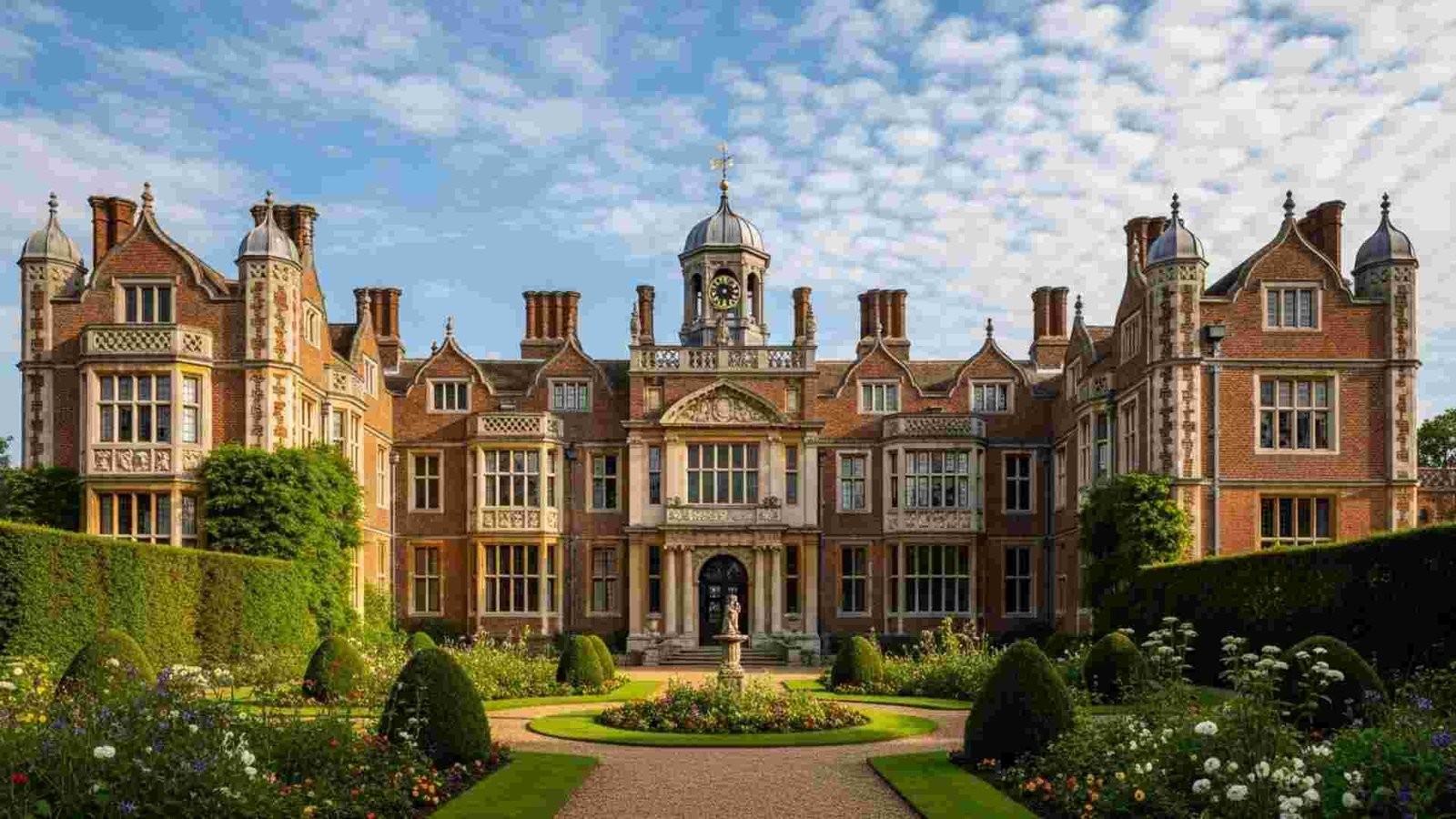
Hatfield House is the kind of estate that makes you whisper “wow” under your breath. A 17th-century Jacobean mansion set on the grounds of Queen Elizabeth I’s childhood home, it’s where royal heritage and quiet countryside elegance blend perfectly. Its ornate red-brick façade, symmetrical gardens, and collection of fine art make it feel like stepping straight into a Bridgerton ballroom — minus the corsets.
This is one of the most accessible “grand homes” near London. Only 21 miles from the capital, you can easily make a day trip to explore its staterooms, sculptures, and 40 acres of landscaped gardens. You’ll find tapestries, carved staircases, and even original Tudor artefacts in the Old Palace. It’s the kind of place where history feels intimate, not overwhelming.
Key Practical Information:
- Location: Hatfield, Hertfordshire
- Getting There: Thameslink or Great Northern train from London King’s Cross (25 min)
- Opening Hours: Wed–Sun 10:30 am – 5:00 pm (closed Mon–Tue)
- Tickets: Adults £22, Children £10 (online)
- Best Time: May–September (gardens in full bloom)
- Ideal Duration: Half day (3–4 hours)
- On-Site: Stable Yard Café, gift shop, weekend markets.
4. Syon Park (Brentford, West London)
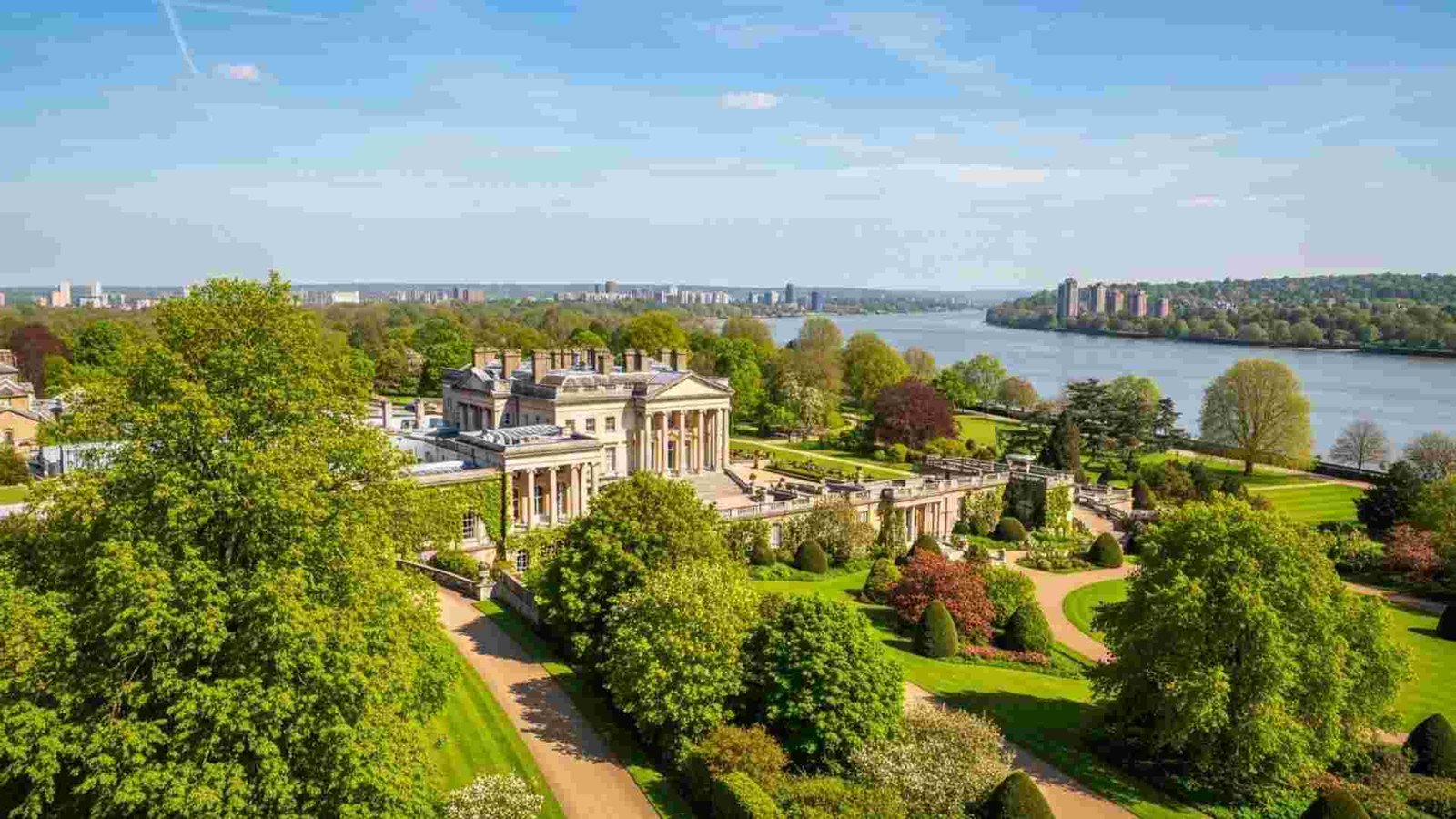
Syon Park is a secret pocket of Georgian luxury just outside central London. Home to the Duke of Northumberland for over 400 years, this 200-acre estate feels surprisingly peaceful given it sits under the Heathrow flight path. The interiors — designed by Robert Adam — sparkle with neoclassical elegance, all columns, domes, and marble. If Bridgerton had an “inner-London country escape,” this would be it.
Outside, Capability Brown’s landscapes stretch toward the Thames with lakes, arboretums, and lawns that seem endless. The Great Conservatory, a vast glasshouse from 1820, is another highlight. It’s a lovely alternative to the more tourist-packed palaces — smaller crowds, slower pace, and free parking.
Key Practical Information:
- Location: Brentford, West London (TW8 8JF)
- Getting There: Nearest Station – Syon Lane (10 min walk)
- Opening Hours: Wed, Thu, Sun & Bank Holidays 10:30 am – 4:30 pm
- Tickets: Adults £15.50 (online), Children £8.50
- Best Time: May–June (roses & wisteria in bloom)
- Ideal Duration: 2–3 hours.
- On-Site: Garden Centre Café, free parking, gift shop
5. Royal Crescent (Bath, Somerset)

The Royal Crescent is pure Bridgerton aesthetic — that sweeping arc of golden Georgian townhouses overlooking a tidy lawn. Built between 1767 and 1774 by John Wood the Younger, it’s Bath’s crown jewel and one of the best-preserved examples of Georgian architecture in the world. You stand there and half-expect a carriage to roll up and Lady Whistledown to start narrating.
Inside No. 1 Royal Crescent, now a museum, rooms are staged exactly as they were in 1776 — chandeliers, silk drapes, servant quarters below. Step outside and you’re minutes from Bath’s Roman Baths, the Circus, and the Royal Victoria Park. The whole city feels cinematic — which is why it’s regularly used for filming.
Key Practical Information:
- Location: Bath, Somerset (BA1 2LR)
- Getting There: Train from London Paddington → Bath Spa (1.5 hrs)
- Opening Hours (No. 1 Royal Crescent): Tue–Sun 10:00 am – 5:00 pm
- Tickets: Adults £16.50, Students £14.50, Children £8.50
- Best Time: April–October (pleasant weather for walking the city)
- Ideal Duration: 2 hours (minimum) + time to explore Bath.
- Nearby: The Royal Crescent Hotel & Spa (afternoon tea treat), local cafés within 5 minutes
6. Wilton House (Wiltshire, England)
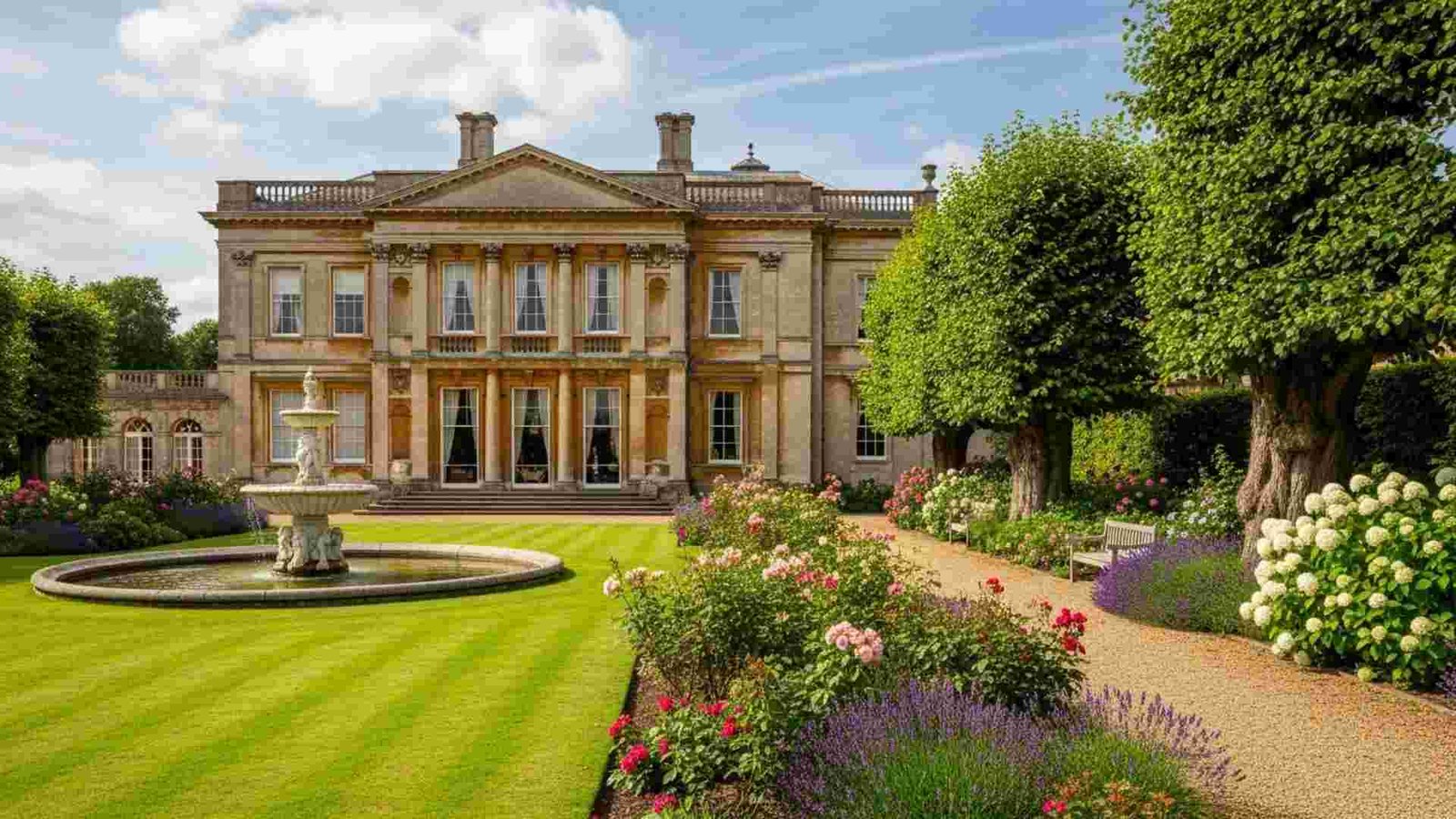
Wilton House isn’t just elegant architecture — it’s the place where you’ll recognise rooms or façades from numerous period dramas (including Bridgerton) and then realise you’re standing there. For example, the “Double Cube Room” and grand façades have starred in many film and TV productions.The layers of history go back centuries: the estate has been the home of the Earls of Pembroke since the 1540s.A walk through the house and the gardens feels like stepping into a story where aristocrats once held court, but you’re free to wander and imagine.
Picture arriving in the late afternoon, the golden light streaming through the large windows of the Long Gallery. You’re the guest who’s just slipped away from the ball in one wing to find a quiet window seat. Outside the river flows gently past the Palladian bridge (one of the earliest in England) and kids in the grounds are perhaps playing in the adventure playground while you linger with a coffee. It’s that contrast: high drama inside, relaxed country estate outside.
Key Practical Information:
- Location: Wilton, near Salisbury, Wiltshire SP2 0BJ.
- Opening / access: House & Grounds open Thurs & Sun for free-flow; Mon-Wed guided tours start 11:30 am until ~3:30 pm; closed Fri/Sat in some seasons.
- Tickets (2025 guide): House+Grounds: Adult ~ £19, Child ~ £10; Grounds only: Adult ~ £8.
- Why go: Film-location “spotlight”, historic art collection, expansive gardens & playground for kids.
- Tip: Check website ahead – house may close for family events, and gardens are vast so leave time.
7. Stowe House & Gardens (Buckinghamshire, England)
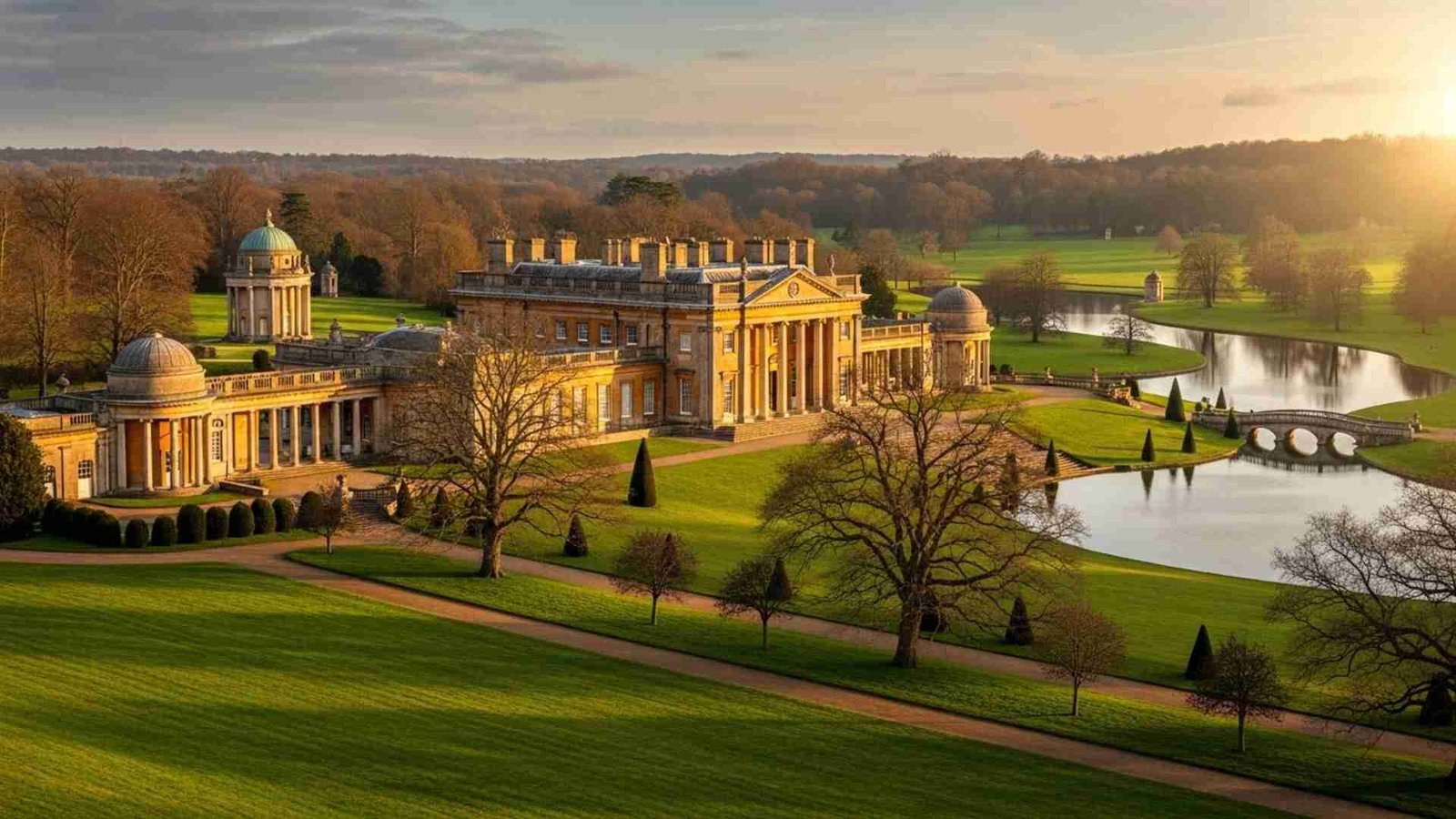
Stowe House and its gardens aren’t only about the mansion — the wider landscaped grounds were designed to convey ideas. The gardens are full of classical temples, mythic references, and the work of the famous landscaper Lancelot ‘Capability’ Brown, who made his mark here.The house itself has undergone major restoration in recent decades, so you’re seeing both history and the effort that keeps it alive.
Imagine taking a walk through the “Grecian Valley” in the gardens, the Temple of Ancient Virtue across the water, and then ascending the steps back up to the house’s south front. You pause at a decorative statue of a classical hero, reflect on how the estate’s creators used art and architecture to show power and taste — and you feel the air of a story unfolding, as if a ball could start in the Marble Saloon at any moment.
Key Practical Information:
- Location: Stowe, Buckinghamshire MK18 5EH.
- Getting there: Train to Milton Keynes (30 mins from London Euston) or Bicester North (50 mins from Marylebone) then bus or taxi.
- Tickets: House ticket adult ~ £9.50; National Trust members ~ £7.50.
- Why go: A blend of architecture, gardens full of symbolism, and less-crowded than some big palaces.
- Tip: Wear good walking shoes – gardens spread wide, some uphill slopes. Check house opening days (it’s also a school).
8. Osterley Park and House (West London, England)
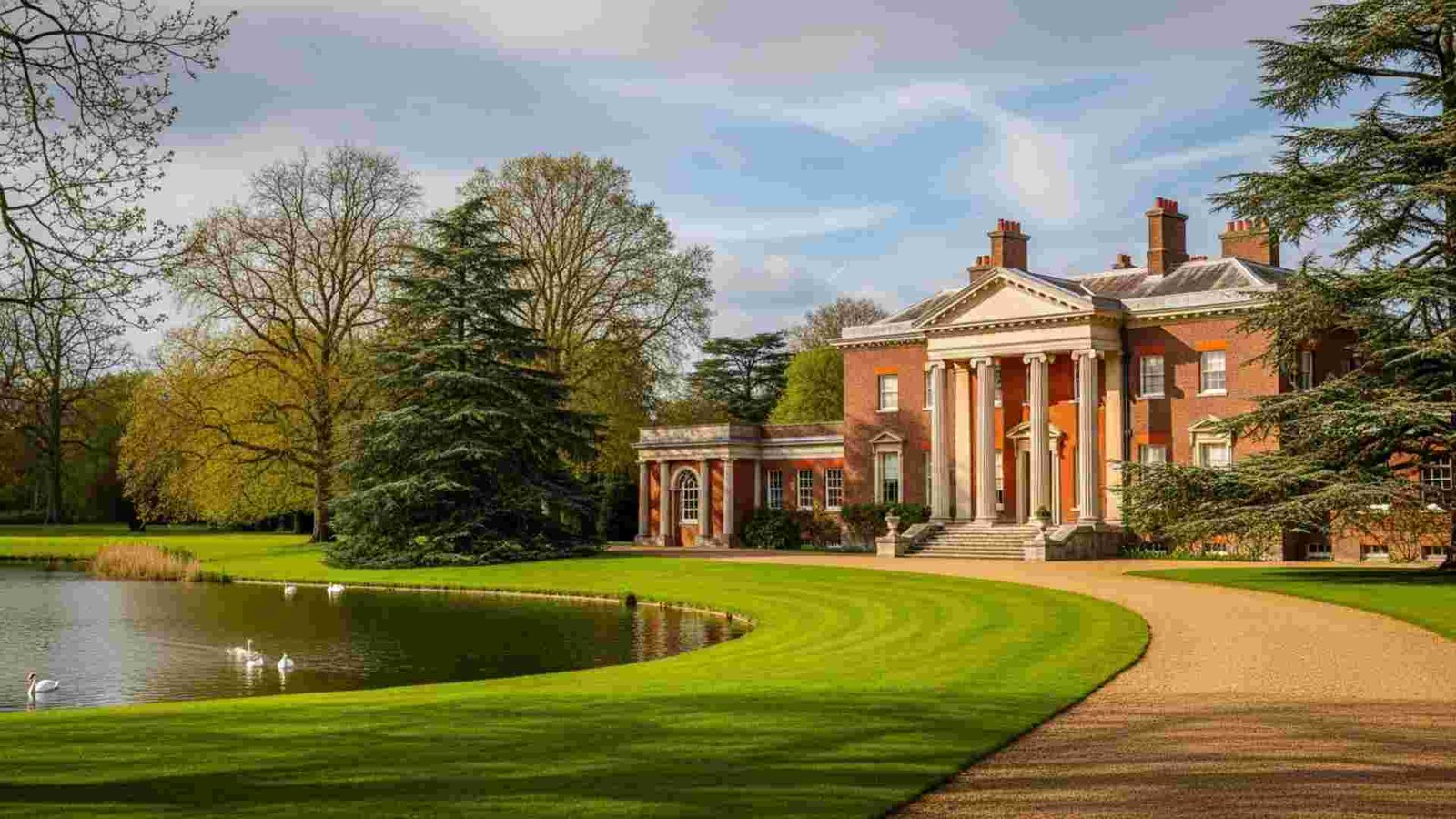
right in the London area yet giving you that country-estate feel. The house was originally Tudor (1570s) and then re-imagined in the 1760s by the architect Robert Adam in the neoclassical style — inside you’ll find Etruscan-style decor, the big portico, and lavish interiors. Meanwhile the grounds span 142 acres of parkland, lakes and gardens.
You’ve left central London behind for a moment, but instead of countryside roads you pull into a grand red-brick mansion. Inside the drawing-room you trace delicate plasterwork — “worthy of Eve before the fall,” one contemporary observer said.Then step outside into the garden, through the Garden House and across the Tudor walled-garden where exotic plants once grew under Sarah Child’s care.It’s the kind of place where you’d expect a masked ball under chandeliers, then a walk in the park at dawn.
Key Practical Information:
- Location: Jersey Road, Isleworth, Middlesex TW7 4RB.
- Getting there: Nearest Tube: Osterley Station; bus routes H28, H91.
- Open/House Info: Gardens open wider; House generally Wed–Sun 1pm–4:30pm (varies).
- Why go: A wonderful balance of grand interiors and accessible outdoors; film-friendly too.
- Tip: Combine with a visit to nearby West London suburbs for lunch; check for any restoration closures.
9. Belton House (Lincolnshire, England)

Belton House often flies a little under the mainstream estate radar — which means it’s a gem for serious fans looking for something a bit more relaxed. Built around 1685–87 in the Carolean style and surrounded by woods, deer park and gardens, it offers both elegance and space.The gardens themselves include a Conservatory (built ~1820) and Dutch Garden later on — great for those who enjoy details beyond the façade.
You arrive and a herd of fallow deer wanders near the edge of the lawn. Inside the house you spot portrait after portrait of the Brownlow family and rare Chinese porcelain in the lavish interiors. Then you exit into the Italian Garden with its topiary and fountains, or into the huge adventure playground (especially fun if you’ve got younger travellers with you). The mixture of refined rooms and open green parkland gives it a rich-but-not-stuffy vibe.
Key Practical Information:
- Location: Belton, near Grantham, Lincolnshire NG32 2LW.
- Opening: Gardens & house open daily (check website).
- Why go: Less crowded, strong historic architecture + extensive grounds, very good for families.
- Tip: Cellar café in the old stables is worth the stop; deer might wander—so keep an eye out.
10. Wrest Park (Bedfordshire, England)
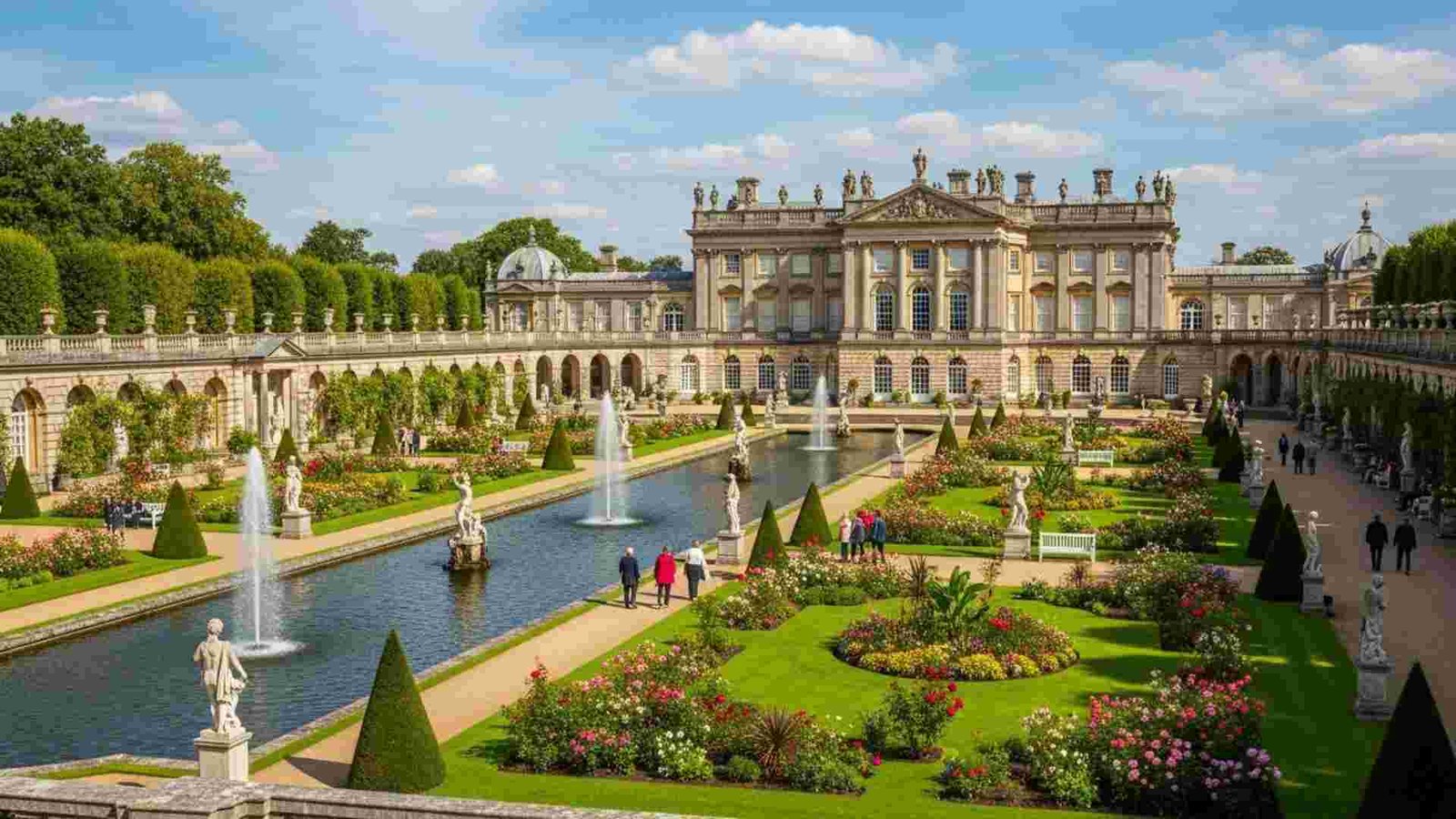
Wrest Park isn’t as famous as some stately homes, but that’s part of its appeal. The gardens are inspired by Versailles: expansive parterres, long canals, formal statues and woodland walks.The house is less lavish than some palaces you’ll visit but the combination of architecture + garden design + tranquility makes it compelling. A twenty-year restoration is underway so you’re also seeing the revival of something real.
Stroll along the “Long Water,” the formal canal, flanked by trees and statues. You find the Chinese Bridge and the Bath House tucked away in the woodland. Inside the mansion you wander through state rooms that echo the 19th-century French château style (the current building dates to 1834).Then you sit on a bench in a quieter part of the gardens, the sounds muffled, and reflect on the centuries of design and change here. It’s a little more contemplative than “palace-flash” and that makes it special.
Key Practical Information:
- Location: Silsoe, Bedfordshire MK45 4HR.
- Opening/Entry: Open daily, 10:00 am-4:00 pm (last entry 3:00 pm) via English Heritage.
- Why go: Elegant gardens with less tourist-pressure; good for slower paced visits.
- Tip: Paths may be uneven in parts; suitable footwear helps. Bring a picnic and linger in the grounds.
11. Holburne Museum, Bath (Somerset, England)

Stepping into the Holburne Museum feels a bit like slipping into a private drawing-room of a Georgian grand house — rich with art, texture, and stories quietly waiting to be discovered. Housed in a Grade I-listed building at the top of Great Pulteney Street, the museum anchors itself in elegance and history. The heart of its collection began with the 19th-century amassed treasures of Sir William Holburne — Italian and Dutch paintings, silverware, porcelain, bronzes — and today it continues to evolve with temporary exhibitions and contemporary commissions.
Beyond the rooms full of fine art, one of the delights is the way the museum connects you back to Bath itself. Walk out of the galleries and you’re facing the serene lawns of Sydney Gardens, or descending Great Pulteney Street — one of the most striking Georgian thoroughfares in the UK. For anyone writing a travel piece, the Holburne offers that “Bridgerton-style” charm without feeling over-the-top: refined, intimate, layered with culture. You’ll linger longer than you think — in the Café, the shop, the quiet corners of the permanent collection.
Practical Information:
- Address: Great Pulteney Street, Bath BA2 4DB.
- Tickets (2025 guide):Full price: £16.50
- Access & Transport:About a 15-minute walk from Bath Spa train station via city centre to Great Pulteney Street.
- Facilities & Tips:Garden Café overlooking Sydney Gardens — perfect for a relaxing pause.
12. Basildon Park (Berkshire, England)
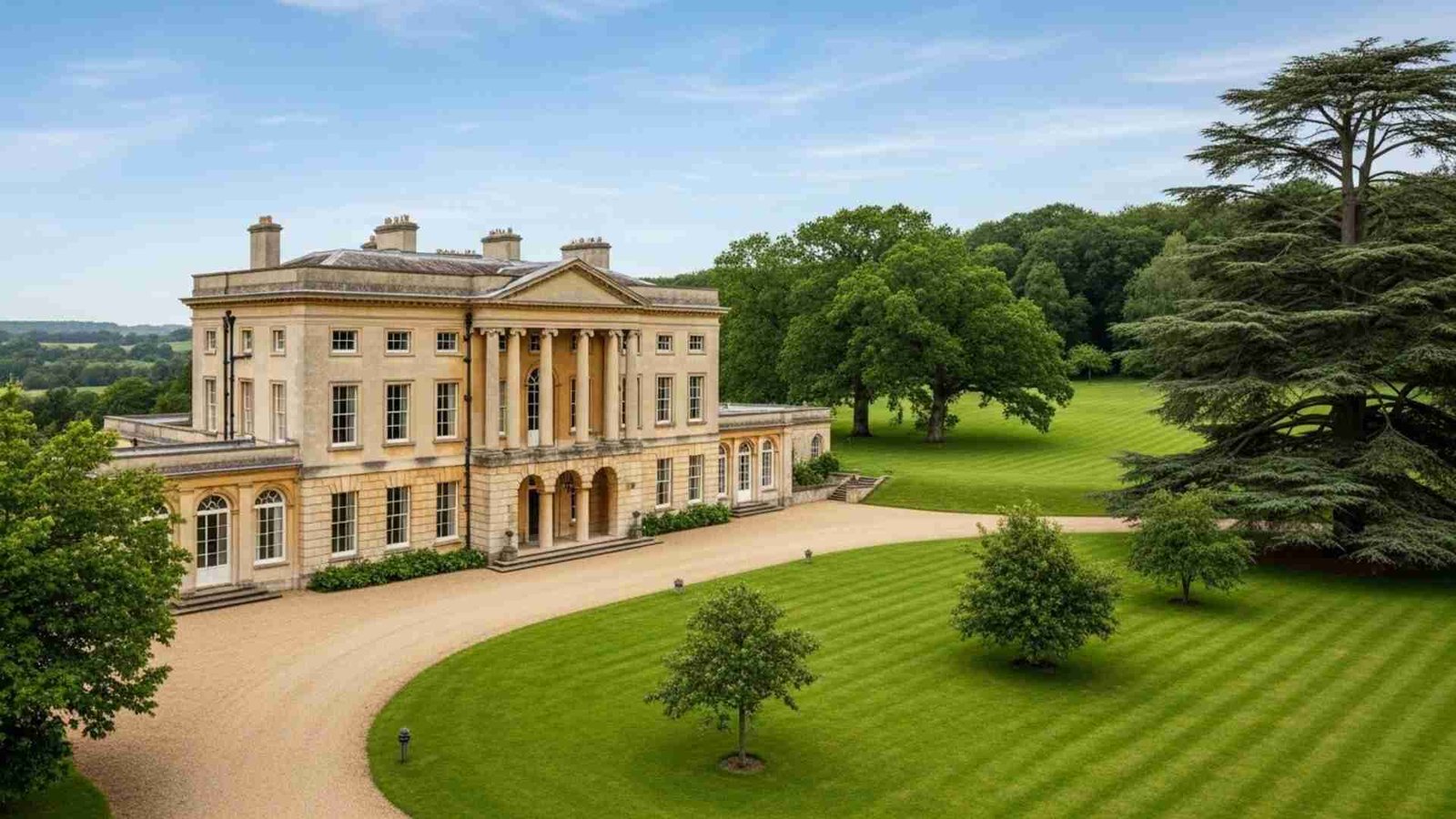
Here’s one that has a story of redemption. Basildon Park was built 1776-83 in the Palladian style, then fell into near-dereliction, was used as a POW camp, nearly demolished, then rescued and restored. That arc gives it a kind of “ruin-to-elegance” backdrop that you can sense when you walk through the rooms and out onto the lawn.
you’re in the drawing-room, heavy ceilings, gilt details, and simultaneously your mind drifts to what this place endured in the 20th century—a house that’s been through war, neglect, revival. Then you step outside across lawns, parkland and you realise the contrast between the formal-front and wilderness edges is part of its charm.
Key Practical Information:
- Address: Lower Basildon, Reading, Berkshire RG8 9NR.
- Getting there: Exit M4 at J12, follow brown signs for Basildon Park.
- Opening & tickets: Varies by season; non-National Trust members pay around £19 for house & grounds.
- Tip: After exploring the fancy rooms, go for a stroll in the 162-acre parkland for bluebells (spring) or autumn colours. Dogs on leads welcome.
13. Ranger’s House (Greenwich, London)

Let’s step behind the elegant red-brick façade of Ranger’s House — a Georgian villa quietly perched on the edge of Greenwich Park and Blackheath. Built in the early 1720s for Francis Hosier, a naval officer, it later became the official residence of the Ranger of Greenwich Park from 1815.Inside, you’ll find the famed Wernher Collection—over 700 works of fine and decorative art amassed by billionaire collector Sir Julius Wernher. Even the exterior may ring a bell for fans of Bridgerton: the house was used as the exterior location for the Bridgerton family home.
it’s tucked into a park boundary rather than in a cluster of major tourist palaces, Ranger’s House offers a refreshing blend of prestige and peacefulness: you’ll explore formal interiors one moment, then step into the garden and look out toward the lush lawns of Greenwich Park. It’s ideal for a refined detour in London that still delivers that “period-drama ambiance.”
Practical Information:
- Address: Chesterfield Walk, Blackheath, London SE10 8QX.
- Getting there: Closest DLR station – Cutty Sark; bus 53 or 386 from nearby Greenwich/Deptford Bridge. You’ll have a bit of uphill walk from transit.
- Tickets (guide): Adult from ~ £10, Child from ~ £5.90, Family (1 adult + up to 3 children) from ~ £15.90.
- Opening / Access Notes: Check the English Heritage website — sometimes the house is closed for events or restoration.
- Facilities & tips: Free (very limited) parking outside the house; no café inside—bring a snack or plan to stop nearby. Dogs on leads allowed in garden only. No photography inside the house.
- Best time to visit: Choose morning hours to avoid crowds; after the interior visit, linger in the adjoining Rose Garden and park for a relaxed break.
14. Wrotham Park (Hertfordshire, England)
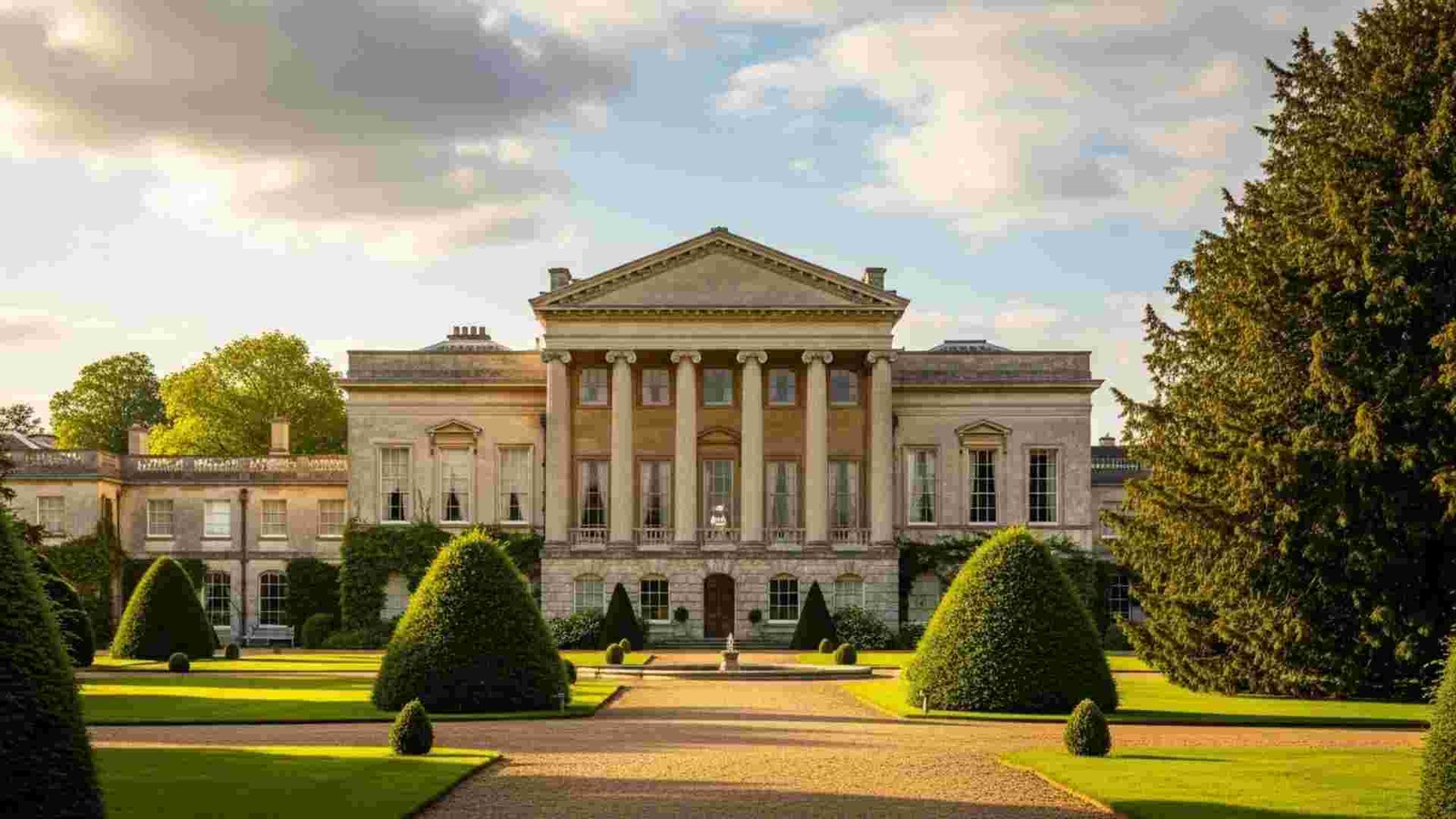
Wrotham Park feels like a movie set—and that’s no accident. The estate covers huge parkland (circa 116 ha in the gardens plus 1,000 ha farmland) and the house has served as a backdrop for many films.
it’s right under the nose of London (12 miles north of Hyde Park Corner) yet manages to feel remoteYou arrive via the curved driveway through wrought-iron gates, the stately façade ahead catches the light late afternoon, and you realise why directors keep coming here. Then you wander into the park and look westwards to the distant countryside beyond the gardens. That view through the valley gives you pause.
It’s perfect for the Bridgerton vibe of graceful design meets sweeping land.
Key Practical Information:
- Location: South Mimms, Hertfordshire (near Potters Bar)
- Access: Private estate—public access may be limited. Always check event listings or open days.
- Hidden gem tip: If you find an open-day, go later in the afternoon when the light hits the front steps; bring binoculars for far views west.
- Visit length: Depending on access, allow 1-2 hrs in gardens, more if house access permitted.
15. Kingston Bagpuize House (Oxfordshire, England)

This one is slightly off the major-tourist radar, which makes it a delightful surprise. The house sits in the Vale of the White Horse, gardens and parkland wrap around it, and the atmosphere is more intimate than big palaces. The house is licensed for civil ceremonies, which speaks to its versatility and charm.
you stroll through the main entrance, domestic yet elegant, you come into the lawn beyond the fountain, the house behind you, the countryside gently rolling away. It’s easy to imagine characters stepping out of the drawing-room onto the terrace at dusk.
because it’s less talked about, you often have fewer crowds, more space to imagine your own scene, more quiet to sit in the garden and reflect rather than rush room-to-room.
Key Practical Information:
- Address: Kingston Bagpuize House, Kingston Bagpuize, Abingdon-on-Thames OX13 5AX.
- Parking: Free parking available; disabled spaces near the house.
- Getting there: By car via A415; by bus Stagecoach 66 Oxford ↔ Swindon via Faringdon.
- Tip: Check seasonal opening – website notes that house may be closed for general visitors outside events or filming periods.
Conclusion:
In the end, these estates and towns aren’t just pretty backdrops — they’re living reminders of Europe’s grand past, where love stories and whispered scandals feel entirely possible. Whether you’re strolling through a rose garden, tracing marble staircases, or sipping tea in a Georgian square, each place offers its own touch of “Bridgerton” magic. And the best part? You don’t need a title or a ballroom invitation — just a sense of curiosity and a willingness to wander where history still dances in the air.


